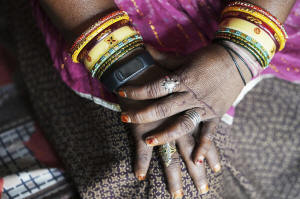In this Indian city, smartwatches are part of the solution to dealing
with searing heat
[May 01, 2025]
By SIBI ARASU
AHMEDABAD, India (AP) — It’s a little past 10 a.m. and the heat is
already blazing on the outskirts of the Western Indian city of Ahmedabad.
Sapnaben Chunara, a 30-year-old mother of three, has just finished her
morning chores. She seeks respite from the heat in the shade of a neem
tree, a species that can withstand high temperatures and drought.
Chunara spends most of the day outdoors in Vanzara Vas, a low-income
neighborhood of about 800 families, because her tin-roofed house is even
hotter. Indoor temperatures can be even higher, especially when outside
they climb above 40 degrees Celsius (104 F).
That was once rare but now happens regularly. And this year, high heat
started three weeks earlier than in previous years, touching 43 degrees
Celsius (109.40 F) in early April.
“Sometimes it gets so hot, I can’t think straight,” said Chunara,
sporting a black smartwatch that contrasts sharply with her colorful
bangles and sari.
Chunara is one of 204 residents of Vanzara Vas given the smartwatches
for a year-long study to find out how heat affects vulnerable
communities around the world. The watches measure heart rate and pulse
and track sleep, and participants get weekly blood pressure checks.
Researchers also painted some roofs with reflective paint to reduce
indoor heat and will compare them to homes without so-called cool roofs
using indoor heat sensors. Along with the smartwatches, this will help
them understand how much cool roofs can help poor households deal with
India’s scorching summers.

Chunara, whose home didn't get a cool roof, said she's happy to
participate by wearing the watch, confident the results will help her
family, too.
"They might paint my roof as well and they might be able to do something
that helps all of us in this area cope with the heat better,” Chunara
said.
Killer heat is the new normal
Cities like Ahmedabad have always had hot summers, but now they're
nearing the threshold beyond which exposure for more than a few hours
can be fatal.
In the summer of 2010, the city witnessed nearly 1,300 excess deaths —
how many more people died than would be expected — which experts found
were most likely due to high temperatures.
An increasingly hot planet, due largely to burning fossil fuels such as
coal and gas that release carbon dioxide and other greenhouse gases,
means already hot regions are getting even worse.
A 2023 study estimated that if the global mean temperature continues to
rise to just under 2 degrees Celsius (3.6 degrees Fahrenheit), there
would be a 370% rise in heat-related deaths around the world and most
would happen in South and Southeast Asia and Africa.
“This is a big concern, and it also shows the heat divide” between the
poor and wealthy, said Abhiyant Tiwari, a climate expert with the
Natural Resources Defense Council and part of the group conducting the
research in Ahmedabad.
[to top of second column]
|

A wristwatch-style health monitor to study how heat affects
vulnerable communities is worn by Shantaben Vanzara at her house in
Ahmedabad, India, Wednesday, April 2, 2025. (AP Photo/Ajit Solanki)

Following the 2010 tragedy, city
officials, with help from public health and heat experts, devised an
action plan to warn citizens when the heat is at dangerous levels
and prepare city hospitals to respond rapidly to heat-related
illness. The plan has been replicated across India and other parts
of South Asia.
The last two years have been the
world’s hottest ever, and researchers hope their work can provide an
additional line of defense for those who bear the brunt of
increasing heat.
Finding solutions to deal with heat
The Ahmedabad study is only one part of a global research project
examining how heat is affecting poor, vulnerable communities in four
cities across the world. Researchers also are measuring heat impacts
using smartwatches and other devices in Africa's Burkina Faso, the
Pacific island of Niue near New Zealand and in the Sonoran desert
region in Mexico.
More than 1.1 billion people — about one-eighth of the world's
population — live in informal settlements and poor neighborhoods
that are particularly vulnerable, said Aditi Bunker, environmental
health researcher associated with the University of Auckland, New
Zealand, and Heidelberg University, Germany, who is leading the
global project.
“Climate change and heat are ravaging populations. And now the
question comes, what are we doing to address this?” she said,
referring to the motivation behind the research.
In Ahmedabad, Bunker, along with researchers at the Indian Institute
of Public Health Gandhinagar and the Ahmedabad Municipal
Corporation, is constantly collecting relevant health data.
If they find that cool roofs effectively reduce indoor heat, they
plan to paint the roofs of all the homes. Researchers hope their
study leads to more use of solutions like cool roofs for poor,
vulnerable populations around the world — and that policymakers will
factor in such solutions when deciding how their countries and
communities can adapt to increasing heat exposure.

For now, Vanzara Vas residents like Chunara and her neighbor,
Shantaben Vanzara, said they will take any help they can get.
Shantaben Vanzara said the heat has made her diabetes worse, but
being part of the study has provided her family some respite. “We
don’t get to sleep because of the heat," she said. "After the roof
got painted, we can sleep for a few hours a night at least.”
Chunara said temperatures used to be predictable.
“Now we don’t know when or what will happen,” she said. “The only
thing that we know for sure is that the heat is getting worse every
year.”
All contents © copyright 2025 Associated Press. All rights reserved |